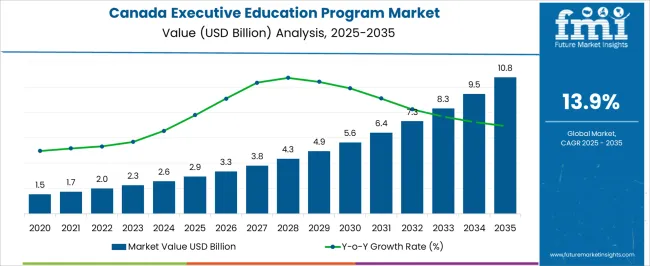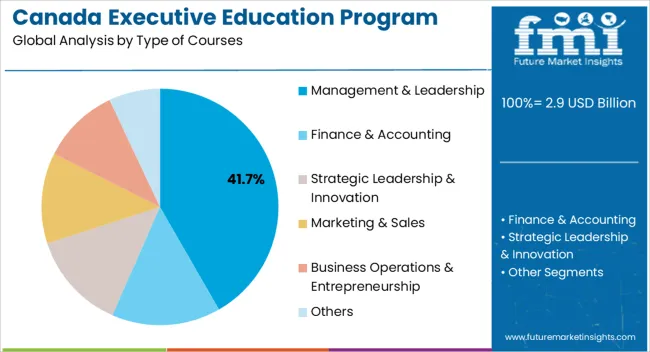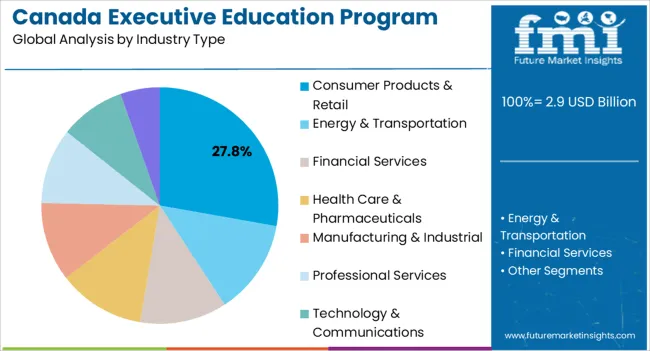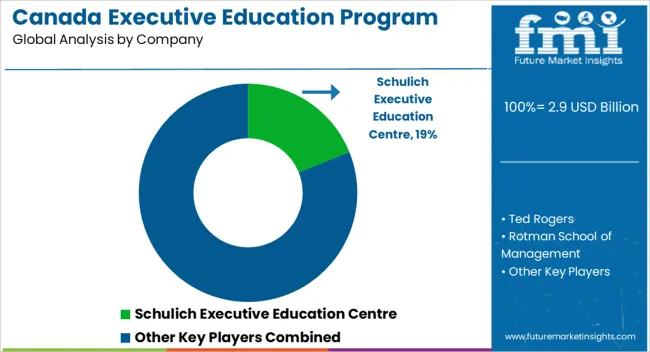The Canada Executive Education Program Market is estimated to be valued at USD 2.9 billion in 2025 and is projected to reach USD 10.8 billion by 2035, registering a compound annual growth rate (CAGR) of 13.9% over the forecast period.

| Metric | Value |
|---|---|
| Canada Executive Education Program Market Estimated Value in (2025 E) | USD 2.9 billion |
| Canada Executive Education Program Market Forecast Value in (2035 F) | USD 10.8 billion |
| Forecast CAGR (2025 to 2035) | 13.9% |
The Canada executive education program market is experiencing steady expansion driven by the growing need for leadership upskilling, digital transformation, and evolving workforce demands. Organizations are increasingly prioritizing executive education to strengthen leadership pipelines, enhance strategic decision making, and adapt to rapidly changing market conditions.
Universities and business schools are collaborating with industry to offer programs that align with emerging business trends such as sustainability, digital innovation, and global competitiveness. Demand is further supported by corporate commitments to lifelong learning and professional development initiatives that help executives stay agile in dynamic economic environments.
The outlook remains favorable as senior leaders seek flexible, high impact programs that combine academic rigor with practical insights, ensuring that Canada continues to strengthen its position as a hub for executive learning.

The management and leadership course type is projected to account for 41.70% of total market revenue by 2025, positioning it as the most dominant offering. This is attributed to the high demand for leadership development programs that address organizational challenges such as change management, cross functional collaboration, and innovation leadership.
Executives are increasingly enrolling in structured programs that enhance strategic thinking and decision making while providing tools for navigating disruption.
The ability of these courses to deliver measurable impact in organizational performance and leadership capabilities has solidified their status as the leading course type in the market.

The consumer products and retail segment is expected to capture 27.80% of market revenue by 2025 within the industry type category, making it the most prominent industry. This is driven by the sector’s heightened focus on customer centric strategies, supply chain agility, and digital commerce transformation.
Executives within this industry face complex challenges such as fluctuating consumer demand, rapid technological adoption, and sustainability mandates. As a result, organizations are prioritizing executive programs that provide actionable insights, enhance resilience, and cultivate adaptive leadership.
This has reinforced the consumer products and retail sector as the primary participant group in executive education in Canada.
Future Market Insights (FMI) estimates that executive education program sales for the historical period 2020 to 2025 were USD 1,992.9 million with a CAGR of 9.7%. In the forecast period, this market is expected to grow at 13.9% CAGR with a valuation of USD 8,341.4 million.
Historically, between 2020 to 2025, the market grew at a CAGR of 9.7%. At the end of 2025, the total revenue for this market was pegged at USD 1,992.9 million. Over the forecast period 2025 to 2035, the market is expected to grow to USD 8341.4 million at a CAGR of 13.9%.
In the current year 2025, the executive education program industry is set to be revolutionized to become innovation focused. It aims to facilitate a multi-disciplinary process integrated with critical thinking.
By the end of 2035, customized executive education would assist organizational leaders in developing extant and new talent capabilities. Strategy building and AI programs would act as icebreakers for the complex business challenges.
E-learning would be highly appreciated by organizations as these programs would decrease the digital skills gap. The combination of low cost, high convenience, and accessibility is expected to transform e-learning into the predominant educating force.
From an organizational perspective, every dollar spent on learning results in three-fold productivity. The competitive spirit and elevated flexible work environment is expected to make education simple for individuals. This will also help employees pursue their own development while working full-time.
The executive education industry is becoming competitive with many universities and business schools offering similar programs. This has resulted in a saturated market, making it difficult for new entrants to gain a foothold.
Innovating the learning experience using AR/VR and gamification would allow new players to gain a competitive edge.
In the Canadian executive education market, lack of diversity in program offerings is challenging. As the business landscape evolves, there is a growing need for programs that cater to emerging fields, such as technology and sustainability.
This lack of diversity may limit the appeal of existing programs.
The cost of technology is likely to restrain growth by the end of the forecast period. Market players infusing high investment for next-generation technologies would be likely to be able to attract organizations and executives for enrollment.
Organizations to Leverage Customized Executive Learning Courses for Employee Upskilling
Customized programs are expected to gain popularity during the forecast period 2025 to 2035. This segment is expected to witness high demand from the corporate sectors and grow at a CAGR of 16.4%.
These programs will provide tailored solutions and cater to the specific needs of organizations and executives. It would allow them to focus on developing skills that are relevant to their industry and job roles.
This personalized approach can lead to higher engagement and better outcomes.
By the end of forecast period, growth in the Canada executive education market would create a competitive environment for organizations. Transformation in employee engagement methods will help in fostering a culture of continuous learning and development.
This would also help to attract and retain top talent, as well as enhance the organization’s reputation as a leader in the industry
Currently, the pre-designed segment holds a predominant share of 55.3%. The customized program segment, however, is projected to grab a giant share by 2035.
Management and Leadership Courses to Facilitate Efficient Decision-making Practices in Corporate Houses
As per the Future Market Insights (FMI) report, management & leadership courses are expected to witness high demand in the Canada executive education industry. This course is expected to grow at a CAGR of 14.2%.
These programs encourage improved decision-making, increase productivity, develop future leaders, and strengthen teams, among other significant advantages.
The workforce in Canada is becoming diverse, with different generations, cultures, and backgrounds coming together in the workplace. Effective management and leadership require a deep understanding of these differences. This can empower executives with the ability to leverage them to create a high-performing team.
This is why training programs for top leaders, executives, managers at educational institutions are becoming quite popular.
Professional services segment is expected to have growing demand in the Canada executive education program industry. This segment is estimated to hold a significant share of the market, at 24.0% in 2025. Its share is projected to rise at a CAGR of 13.2% during the forecast period.
Industries are constantly changing, and the competition within the professional space is soaring. Continuing education has gained paramount importance among workers to stay abreast with the latest developments, skills, and new technologies.
Certain professions also require continuing education to comply with laws, remain licensed or certified, or maintain membership in an association or licensing body.

Companies providing executive education programs in Canada are seeking strategic alliances and partnerships with other players to diversify their product offerings and meet the need of a growing customer base.
They are also focusing on research and development to come up with technologically advanced systems to enhance their product portfolio.
For instance
| Attribute | Insights |
|---|---|
| Estimated Market Value (2025) | USD 2.9 billion |
| Projected Market Value (2035) | USD 10.8 billion |
| Anticipated Growth Rate (2025 to 2035) | 13.9% CAGR |
| Forecast Period | 2025 to 2035 |
| Historical Data Available for | 2020 to 2025 |
| Market Analysis | USD million/billion for Value |
| Key Regions Covered | North America |
| Key Countries Covered | Canada |
| Key Segments Covered | Type of Courses, Industry Type, Leadership Level, Duration, Program Type, Mode of Learning |
| Key Companies Profiled | Schulich Executive Education Centre; Ted Rogers; Rotman School of Management; UBC Sauder School of Business; Ivey Business School; Simon Fraser University; Smith School of Business; University of Alberta; Haskayne School of Business; Edwards Executive Education; Others (As Per Request) |
| Report Coverage | Market Forecast, Company Share Analysis, Competition Intelligence, DROT Analysis, Market Dynamics and Challenges, and Strategic Growth Initiatives |
The global Canada executive education program market is estimated to be valued at USD 2.9 billion in 2025.
The market size for the Canada executive education program market is projected to reach USD 10.8 billion by 2035.
The Canada executive education program market is expected to grow at a 13.9% CAGR between 2025 and 2035.
The key product types in Canada executive education program market are management & leadership, finance & accounting, strategic leadership & innovation, marketing & sales, business operations & entrepreneurship and others.
In terms of industry type, consumer products & retail segment to command 27.8% share in the Canada executive education program market in 2025.






Our Research Products

The "Full Research Suite" delivers actionable market intel, deep dives on markets or technologies, so clients act faster, cut risk, and unlock growth.

The Leaderboard benchmarks and ranks top vendors, classifying them as Established Leaders, Leading Challengers, or Disruptors & Challengers.

Locates where complements amplify value and substitutes erode it, forecasting net impact by horizon

We deliver granular, decision-grade intel: market sizing, 5-year forecasts, pricing, adoption, usage, revenue, and operational KPIs—plus competitor tracking, regulation, and value chains—across 60 countries broadly.

Spot the shifts before they hit your P&L. We track inflection points, adoption curves, pricing moves, and ecosystem plays to show where demand is heading, why it is changing, and what to do next across high-growth markets and disruptive tech

Real-time reads of user behavior. We track shifting priorities, perceptions of today’s and next-gen services, and provider experience, then pace how fast tech moves from trial to adoption, blending buyer, consumer, and channel inputs with social signals (#WhySwitch, #UX).

Partner with our analyst team to build a custom report designed around your business priorities. From analysing market trends to assessing competitors or crafting bespoke datasets, we tailor insights to your needs.
Supplier Intelligence
Discovery & Profiling
Capacity & Footprint
Performance & Risk
Compliance & Governance
Commercial Readiness
Who Supplies Whom
Scorecards & Shortlists
Playbooks & Docs
Category Intelligence
Definition & Scope
Demand & Use Cases
Cost Drivers
Market Structure
Supply Chain Map
Trade & Policy
Operating Norms
Deliverables
Buyer Intelligence
Account Basics
Spend & Scope
Procurement Model
Vendor Requirements
Terms & Policies
Entry Strategy
Pain Points & Triggers
Outputs
Pricing Analysis
Benchmarks
Trends
Should-Cost
Indexation
Landed Cost
Commercial Terms
Deliverables
Brand Analysis
Positioning & Value Prop
Share & Presence
Customer Evidence
Go-to-Market
Digital & Reputation
Compliance & Trust
KPIs & Gaps
Outputs
Full Research Suite comprises of:
Market outlook & trends analysis
Interviews & case studies
Strategic recommendations
Vendor profiles & capabilities analysis
5-year forecasts
8 regions and 60+ country-level data splits
Market segment data splits
12 months of continuous data updates
DELIVERED AS:
PDF EXCEL ONLINE
Executive Education Program Market Size and Share Forecast Outlook 2025 to 2035
Industry Share & Competitive Positioning in Executive Education Program
Key Companies & Market Share in United States Executive Education Program Sector
Online Executive Education Program Market Trends – Growth & Forecast 2024-2034
Nordics Executive Education Program Market Size and Share Forecast Outlook 2025 to 2035
United States Executive Education Program Market Size and Share Forecast Outlook 2025 to 2035
United States and Canada Educational Tourism Market Growth, Trends and Forecast from 2025 to 2035
Executive Coaching Certification Market Size and Share Forecast Outlook 2025 to 2035
Canada Compact Wheel Loader Industry Analysis Size and Share Forecast Outlook 2025 to 2035
Canada Straws Market Size and Share Forecast Outlook 2025 to 2035
Canada Eyeshadow Stick & Blush Stick Market Size and Share Forecast Outlook 2025 to 2035
Programmable Robots Market Size and Share Forecast Outlook 2025 to 2035
Educational Tourism Market Analysis - Size, Share, and Forecast Outlook 2025 to 2035
Programmable Logic Device (PLD) Market Growth & Demand 2025 to 2035
Canada Space Tourism Market Analysis – Trends, Growth & Forecast 2025-2035
Canada Travel Agency Services Market Trends – Demand, Growth & Forecast 2025-2035
Programmatic Display Market Analysis by Ad Format, Sales Channel, and Region Through 2035
Canada Responsible Tourism Market Insights – Growth, Demand & Forecast 2025-2035
Educational Toys Market Analysis and Overview by Category, End-use Sector, and Area through 2035
Educational Robots Market Analysis by Type, Application, and Region Through 2035

Thank you!
You will receive an email from our Business Development Manager. Please be sure to check your SPAM/JUNK folder too.
Chat With
MaRIA